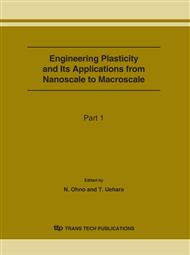p.1437
p.1443
p.1449
p.1455
p.1461
p.1467
p.1473
p.1479
p.1485
Effects of Loading Speed and Shear Prestrain on Adhesive Fatigue Strength in Single-Lap Joint
Abstract:
The adhesive fatigue strength was investigated by performing repeated tensile lap shear experiments of an aluminum single-lap joint bonded with highly ductile acrylic adhesive. In load-controlled fatigue tests, progressive transverse shear deformation of the adhesive layer took place, and it led to the final fracture of the joint. The fatigue strength becomes higher with increasing loading speed, especially at low-cycle fatigue region. From experiments on shear-prestrained specimens, it was found that the prestrain does not affect so much the fatigue life. In order to discuss the behavior of progressive shear strain accumulation (viscoplastic ratcheting) of adhesive under cyclic loading, the numerical simulation of ratcheting was conducted using a constitutive model of elasto-viscoplasticity for the adhesive.
Info:
Periodical:
Pages:
1479-1484
Citation:
Online since:
June 2007
Authors:
Price:
Сopyright:
© 2007 Trans Tech Publications Ltd. All Rights Reserved
Share:
Citation:


